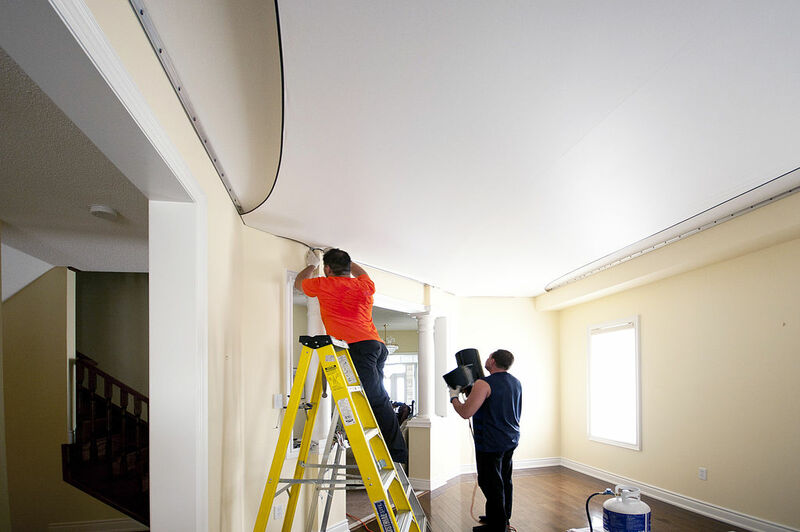Have you seen bubbling ceiling paint? Are you curious about how to fix bubbled water damaged ceiling paint?
If one didn’t instantly take action to repair the water bubble in the ceiling, then it might just cause further damage. Still, taking action without knowing what you’re doing might lead to a mess.

This article will help you fix this problem, so continue reading and learn more.
What Causes The Bubbling Of Ceiling Paint?
The bubbling of paint looks like a specific spot on your ceiling is swelling. It means that there is some liquid gathering behind.
Many ways might cause bubbling, but it involves one factor in common, water in notable cases. This water may be from moisture pooling on your ceiling after a storm, a broken pipe, or painting on a damp surface.
Due to the pressure of the merging of water, it may create paint bubbles. Accumulation of dust or oil, initially wet concrete or wood or drywall, and failure to sand the surface before painting are other reasons that may cause bubbling of paint.
Once water leaks on your ceiling, it can cause quite the damage. It’ll be hard to notice it unless you see the paint bubbling from the collected water.
A giant bubble might result in a bigger mess. So, it is best to immediately act upon it once you see some signs indicating the start of bubbling.
Here are some signs you may want to keep an eye on:
- A spot isn’t as smooth as the rest of the ceiling’s surface.
- The pooling of water causes swirl marks or stains.
- The appearance of hairline-like cracks.
- The paint is starting to peel.
- In the worst-case scenario, you may find mold or mildew growing signs.
You may also see this article regarding how to remove water damaged sheetrock.
How To Fix It
After being aware of the possible causes of paint bubbling, it’s time to continue learning how to fix it. You may use the following steps as guidance on how you would repair paint that bubbled due to water:
Step #1. First, you might want to prepare a bucket and place it below the swelling. Then you’ll need something sharp to poke a hole in the bubble and let the water drain into the readied bucket.
If you are still deliberating how to proceed after popping the bubble, you might as well delay it until you are prepared to do it to the end.
Step #2. Identify the cause of the water bubble in the paint. Then after you know the source, you’ll have to judge if you can fix it on your own or need some professional’s help.
You also have to know if there are some hairline cracks where moisture enters so that you can fix them immediately, too, before proceeding with the following steps.
Step #3. After you have drained the last drop of moisture from the popped bubble and are already done with fixing the source, it’s time to fix the popped paint bubble. To ensure that no water is left, leave it for a while and be sure that the room has good airflow.
Step #4. You’ll need to scrape off the loose paint from the popped bubble for this step.
Step #5. Now, to assure better protection and stronger adhesion, you’ll have to apply a primer. Apply it to the bare spots, then leave it to dry.
Step #6. Finally, you can repaint the already dry primer. Please leave it to dry, and then you’re done.
For further information, you may also visit these two articles concerning ceiling water bubbles and blistering caused by hydrostatic pressure.
Can this be prevented?
It would be hard to prevent storms or pipes from breaking, but what you can do is immediately take action against the source of water. Here are also a few preventative actions you can take note of:
- You may check your roof for possible sources of leaks during the rainy season. Then fix it immediately.
- Repair broken water pipes.
- Be sure to read the instructions labeled on the paint before using it so that you can pay attention to the conditions involved before, during, and after painting.
- Ensure that the surface you’ll be painting is dry and clean.
- Applying primer/sealer before painting is also necessary. Make sure that the primer is dry before applying the paint.
- Evade painting during hot seasons.
- Installing vents or exhaust fans to regulate the airflow and lower humidity inside should also help.
- You may use waterproofing or moisture barrier products to seal gaps where air or moisture can pass through.
For additional information, you may see this article about how to replace water damaged ceiling tiles.
Conclusion
If you’re doing it by yourself, especially if it’s your first time, you may have difficulty. If you find yourself in a challenging juncture or don’t have enough time to repair, you may ask for a professional’s assistance.
Choose to do what brings comfort to you and what is best for your health and safety. Hopefully, this article concerning how to fix bubbled water damaged ceiling paint was able to aid you.
